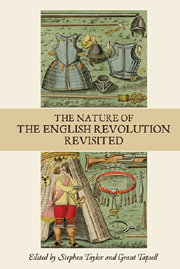Book contents
- Frontmatter
- Contents
- Preface and Acknowledgements
- List of contributors
- List of Abbreviations
- 1 Charles I and Public Opinion on the Eve of the English Civil War
- 2 Rethinking Moderation in the English Revolution: The Case of An Apologeticall Narration
- 3 The Parish and the Poor in the English Revolution
- 4 Body Politics in the English Revolution
- 5 The franchise Debate Revisited: The Levellers and the Army
- 6 Oliver Cromwell and the Instrument of government
- 7 ‘de te fabula narratur’: The Narrative Constitutionalism of James Harrington's Oceana
- 8 Democracy in 1659: Harrington and the Good Old Cause
- 9 The Restoration of the Church of England, 1660–1662: Ordination, Re-ordination and Conformity
- 10 Style, Wit and Religion in Restoration England
- 11 A British Patriarchy? Ecclesiastical Imperialism under the Later Stuarts
- Index
- Studies in Early Modern Cultural, Political and Social History
11 - A British Patriarchy? Ecclesiastical Imperialism under the Later Stuarts
Published online by Cambridge University Press: 05 July 2013
- Frontmatter
- Contents
- Preface and Acknowledgements
- List of contributors
- List of Abbreviations
- 1 Charles I and Public Opinion on the Eve of the English Civil War
- 2 Rethinking Moderation in the English Revolution: The Case of An Apologeticall Narration
- 3 The Parish and the Poor in the English Revolution
- 4 Body Politics in the English Revolution
- 5 The franchise Debate Revisited: The Levellers and the Army
- 6 Oliver Cromwell and the Instrument of government
- 7 ‘de te fabula narratur’: The Narrative Constitutionalism of James Harrington's Oceana
- 8 Democracy in 1659: Harrington and the Good Old Cause
- 9 The Restoration of the Church of England, 1660–1662: Ordination, Re-ordination and Conformity
- 10 Style, Wit and Religion in Restoration England
- 11 A British Patriarchy? Ecclesiastical Imperialism under the Later Stuarts
- Index
- Studies in Early Modern Cultural, Political and Social History
Summary
Twenty years ago John Morrill offered a searching and combative account of the interactions between the state Churches of England, Scotland, and Ireland under the early Stuarts in a festschrift for Patrick Collinson. Conrad Russell was wrong to delineate efforts to achieve English ecclesiastical hegemony across the British Isles: there was simply no court-based, Laudian plan to entrench a ‘British patriarchy’ that would subordinate the Churches of Scotland and Ireland to control from Canterbury. In keeping with Morrill's broader thinking on ‘the British problem’, this was certainly not to deny significant and increasingly controversial interactions between the three kingdoms. James VI & I may not have sought a clear union of the three Churches, but he did become ‘sloppy’ about protecting the autonomy and equality of the state Churches beyond England as he strove for ‘congruity’. Charles I did not aim to impose complete uniformity of religious practice throughout the islands of Britain and Ireland, but he did have a ‘British policy’, one that placed a common stress on the discretionary powers of the crown. In this account, Laud aided and instructed Charles in how best to achieve his goals within each kingdom, but did not covet immediate personal powers over Scottish and Irish clergy. Furthermore, Laud's influence beyond England varied considerably. In Ireland he enjoyed a close personal relationship with Wentworth, and could rely on active support from John Bramhall, bishop of Derry. But in Scotland he had to be ‘far more circumspect’ in his activity.
- Type
- Chapter
- Information
- The Nature of the English Revolution Revisited , pp. 261 - 284Publisher: Boydell & BrewerPrint publication year: 2013

